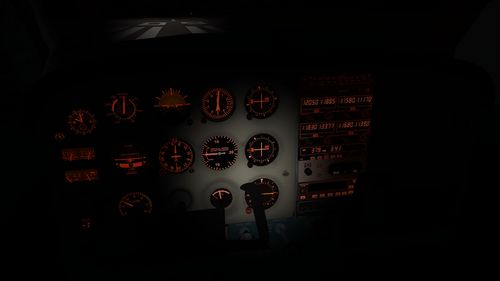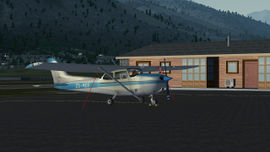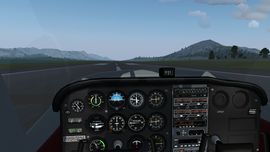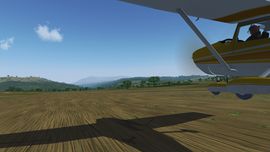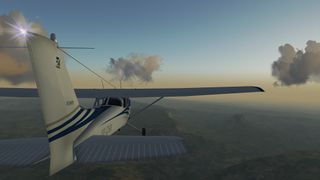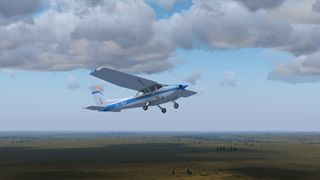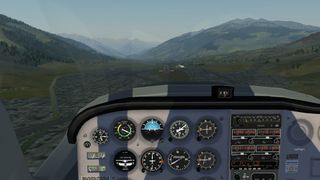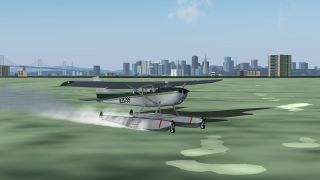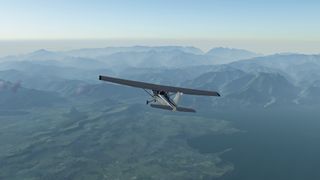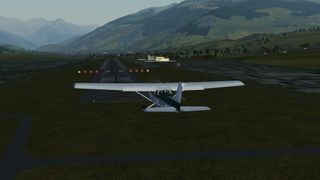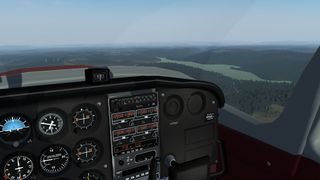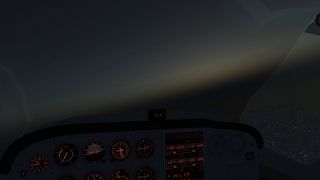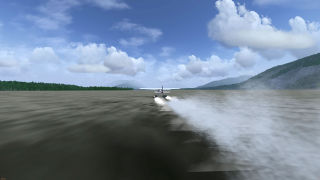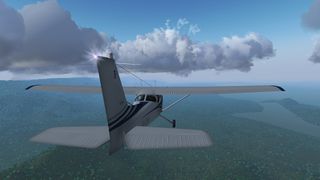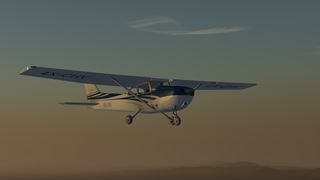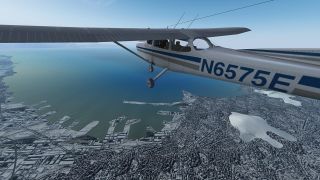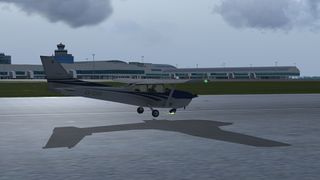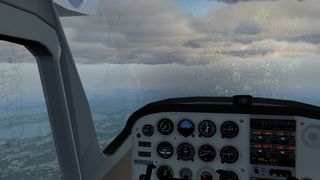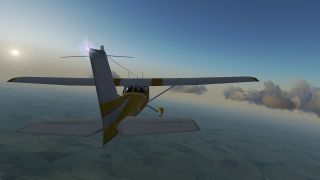Fr/Cessna 172P
 | |
|---|---|
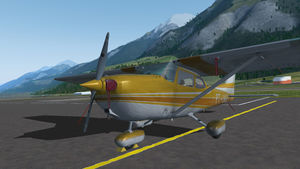 | |
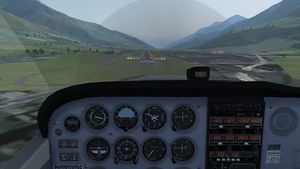 | |
| Type | Aéronef civil, Aéronef utilitaire civil, Glider tug |
| Configuration | High wing aircraft, Fixed gear aircraft |
| Propulsion | Aéronef à hélices, Aéronef monomoteur |
| Constructeur | Cessna |
| Créateur(s) |
|
| FDM | JSBSim |
| --aircraft= | c172p |
| Etat | Production avancée |
| FDM |
|
| Systèmes |
|
| Cockpit |
|
| Modèle |
|
| Soutien |
|
| Développement | |
| Référentiel |
|
| Télécharger |
|
| Livrée |
|
| Forum |
|
| Wikipédia |
Cessna 172 |
|
| |
Le Cessna 172 Skyhawk est un avion quadriplace, monomoteur à aile haute. Il effectua son premier vol en 1955 et est toujours en production, plus de Cessna 172 ont été construits que tout autres avions.
Le C 172 est l'avion par défaut dans FlightGear depuis 2000, il a remplacé le Navion. Il a eu un long développement et il inclut une grande variété de fonctionnalités pour FlightGear. En 2015, il a été complètement rénové ; cela comprend de nouvelles options de moteur, de taille de pneus ou de flotteurs, ainsi qu'une refonte complète du cockpit. Cette nouvelle version détaillée de l'avion est devenu l'avion inclus en standard depuis FlightGear 3.6.
Contenu et variantes
Le nouveau C172p a un bien meilleur modèle 3D et est maintenant complètement texturé (y compris à l'intérieur). Tous les interrupteurs du cockpit sont cliquables. Il a aussi un meilleur FDM, des procédures plus complexes et des checklist réalistes, de nouveaux effets sonores et une modélisation des dégâts. L'avion peut être endommagé s'il n'est pas utilisé correctement (par example le train d’atterrissage se brise si l’atterrissage est trop brutal).
L'avion dispose actuellement de cinq variantes qui sont accessibles depuis le menu de l'avion :
- roues standards
- roues 26 pouces pour le bush
- roues 31 pouces pour le bush
- flotteurs
- amphibie
- skis pour la neige
De plus depuis ce même menu l'utilisateur peut choisir entre deux moteurs :
- 160 HP
- 180 HP (recommandé si on utilise les variantes flotteurs, amphibie ou skis)
L'avion peut désormais être endommagé suite à des collisions, crash, atterrissage difficiles ou surcharges et la modélisation inclus la destruction des roues ou des ailes, etc. Les dégâts peuvent être désactivés dans le menu, il y a aussi une option pour réparer l'avion.
Les fenêtres peuvent recevoir de la buée ou du givre en fonction de la combinaison des températures intérieures et extérieures. Le pilote doit utiliser les commandes d'arrivée d'air ou de chauffage de la cabine (à droite de la commande de volet). Ou alors il est possible de désactiver cet effet dans les options de l'avion dans le menu "Cessna 172P". Ces effets graphiques nécessitent les nouveaux effets ALS de FG 3.5 ou plus récent et risquent de produire des fenêtres grises sur les version antérieures.
Le FDM a aussi été amélioré. L'avion peut entamer une vrille dans une situation de décrochage asymétrique (une situation particulièrement dangereuse lorsqu'on tourne pour la manœuvre finale et que l'avion vole à une vitesse et une altitude faibles). Le FDM a aussi été ajusté pour inclure les effet hydrodynamiques lorsqu'il décolle ou atterrit sur l'eau. Il sait aussi gérer le moteur de 180 chevaux.
Il y a plusieurs livrées disponibles, certaines ont une meilleure résolution que d'autres et sont marquées avec 'HD' dans le menu des livrées. There are several liveries available, some of which have higher resolution than others, which are marked as HD in the liveries menu. Each of the HD liveries also has unique cockpit and interior textures.
L'avion fournit une simulation du Bendix/King KAP140 Autopilot.
Si l'utilisateur a activé ALS (Atmospheric light scattering) dans la boite de dialogue des options de rendu, alors il est possible d'activer la lampe de poche à partir du menu "Cessna 172P" et en choisissant "Flashlight". Activer le une fois pour la lumière blanche, une deuxième fois pour la lumière rouge et une troisième fois pour l'éteindre.
Vous pouvez désormais effectuer la procédure d'avant-vol : cale pour les roues, attaches au sol et protection du pitot peuvent être mis ou enlevé, il est aussi possible de vérifier l'état de l'huile et la contamination du carburant par l'eau (ces fonctionnalités sont désactivées par défaut mais sont disponible dans le menu de l'avion).
Aide de l'avion
Inspection avant le vol
Il est préférable d'utiliser une vue de l’extérieur ou d'utiliser le marcheur (walker) pour ces procédures.
- Niveau de carburant : cliquer que le bouchon de réservoir de chaque aile pour en ajouter
- Aile droite : enlever l'attache
- Aile droite : vérifier la contamination en cliquant sous l'aile pour extraire un échantillon de carburant. Si l’échantillon est bleu pâle alors le carburant n'est pas contaminé et peut être remis dans le réservoir. Si l’échantillon est transparent ou semi-transparent alors vous devez vous en débarrasser et reprendre des échantillons jusqu'à ce que l’échantillon soit complètement bleu pâle.
- Nez : vérifier la quantité en cliquant sur la trappe d'huile. Le niveau critique d'huile pour les moteurs est de 5.0 quarts.
- Nez : enlever la cale.
- Aile gauche : enlever l'attache
- Aile gauche : enlever la protection du pitot
- Aile gauche : vérifier la contamination du carburant
Mise en route (démarrage simple ou complexe)
- Priming: pompez le moteur au moins 3 fois
- Mixture: Riche (manette rouge poussée à fond)
- Gaz: 1/8" (1/2 cm)
- Frein de parking: Serré (⇧ Shift+B)
- Zone autour de l'hélice: Dégagée
- Magnétos: Both (} trois fois)
- Démarreur (S)
Démarrage moteur (automatique avec l'Autostart)
- Dans le menu "Cessna C172P", choisissez "Autostart" puis garder la touche S appuyée pour démarrer l'avion.
Décollage
- Volets rentrés
- Plein gaz
- Rotation à 55 KIAS
Montée
- Volets rentrés
- Plein gaz
- 75 KIAS
Croisière
- gaz: 65%
- mixture: "rich of peak"
Atterrissage
- Volets: tout sorti
- 60 KIAS
Vitesses limites
- Voir aussi Aircraft speed#V speeds
Les informations de cette section sont fondées sur des sources externes. [1][2][3]
| Vitesse (Airspeed) | Vitesse calibrée (CAS) |
|---|---|
| Vitesse de décrochage, configuration pour l’atterrissage, VS0 | 33 kt |
| Vitesse de décrochage, VS1 | 44 kt |
| Vitesse de rotation, VR | 55 kt |
| Vitesse avec le meilleur angle of montée, VX | 59 kt |
| Vitesse avec la montée la plus rapide, VY | 76 kt |
| Vitesse maximale avec les volets sortis, VFE | 85 kt |
| Vitesse de manœuvre, VA | 96 kt (flotteurs) |
| 99 kt (roues) | |
| Vitesse maximale de croisière pour l’intégrité structurelle, VNO | 127 kt |
| Vitesse à ne jamais dépasser, VNE | 158 kt |
FAQ
Here are some of the frequently asked questions about this aircraft:
Q: I am experiencing grey windows, what is happening?
A: If you experience grey windows, you do not have the correct FlightGear version. This aircraft requires 3.5 or above.
Q: Why does the aircraft keep turning left?
A: Please see understanding Propeller Torque and P-Factor. If using the amphibian model on a solid runway, note that at the taxiing is done by differential braking (the rudder becomes more and more effective as the plane gains speed).
Q: Why will the engine not start?
A: You can start the engine automatically by clicking on the menu "Cessna C172P", selecting "Autostart" and then simply holding the key S. For a manual start, please follow the checklists available by clicking on the menu "Help" followed by "Aircraft Checklists". As seen above, the engine must by "primed" before starting. If oil management is activated, you must have enough oil for the engine to work (more than 5.0 quarts). If fuel contamination is activated, the fuel must be light blue in order for the engine to properly work.
Q: Why does the engine die immediately after startup?
A: Probably because the throttle is being incremented too fast after startup as the engine needs a few seconds to stabilize itself.
Q: Why can't I start the sim with the engine running?
A: You can! Go to the menu "Cessna C172P", select "Aircraft Options" and tick the option "Start with engine running".
Q: Why the aircraft doesn't move?
A: The aircraft won't move if you have the parking brakes set, or if either of the wing tie-downs, the tail tie-down or wheel chocks are in place (if the option "allow securing aircraft" is enabled in the aircraft menu).
Q: Why the airspeed indicator doesn't work?
A: If the option "allow securing aircraft" is enabled in the aircraft menu, then very likely you forgot to remove the pitot tube cover.
Q: How can I switch to the bush tires/pontoons/amphibian?
A: By clicking in menu "Cessna 172P", selecting "Aircraft Options" and then selecting the other landing gear options.
Q: How can I switch to the 180 HP engine?
A: This is also done by clicking in menu "Cessna 172P", selecting "Aircraft Options" and then selecting the engine power option.
Q: Why can't I take off from the water without crashing the plane?
A: Taking off and landing on water can be quite tricky. Try applying a little bit of back pressure on the yoke while accelerating to 55 KIAS. It's also recommended to use the 180 HP engine instead of the default 160 HP, as the extra weight of the pontoons make it really hard to climb with the default engine.
Q: Why is the simulator lagging so much?
A: As with any complex 3D model, this new version of the c172p is a bit more demanding on the computers than the older one. If you are having troubles with performance, try using non-HD liveries which use textures with lower resolutions, as well as other solutions that can improve performance (disabling certain graphical options in the Rendering Options, lowering the resolution of FlightGear, etc.).
Some tricks that help to increase fps is by disabling all GUI windows, including the menu bar and the orange fps counters at the bottom of the screen. You can display an alternative fps counter in the top left corner via the "Debug" menu and then selecting "Cycle On-Screen Statistics". Make sure to hide the menu bar by pressing F10 to see the counter.
A second trick is to simply disable the rendering of all clouds if you don't mind. Start FlightGear with "--prop:/sim/rendering/draw-mask/clouds=0".
If you notice heavy slowdowns when flying over certain scenery and you see FlightGear generating many "Warning:: Picked up error in TriangleIntersect" messages in the terminal or log file, you can disable this by starting FlightGear with "--prop:/sim/rendering/osg-notify-level=fatal".
Q: Why are the windows getting foggy/frosty?
A: If the dew point of the cabin air temperature is higher than the surface temperature of the windshield, the windows will get either foggy or frosty. Use the Cabin Heat and Cabin Air levers (on the right of the flaps) to control it. The dew point rises with the temperature in the cabin, and it rises faster than the windshield temperature can adjust, resulting in temporary fog. If the air is very humid, the dew point is going to be very close to the cabin temperature, which makes it likely that it will be higher than the windshield temperature. Extra passengers will create a more humid atmosphere in the cabin. Try to increase air flow using the Cabin Air lever or overhead air vents in order to decrease the humidity or temperature. Alternatively, disable the effect by going to the menu "Cessna 172P", selecting "Aircraft Options" and disable the option "Enable frost and fog".
Q: How do I increase the cabin air temperature?
A: Increase the cabin air temperature by opening the Cabin Heat lever. In order to actually get a heated air flow, you need a medium or high EGT (Exhaust Gas Temperature -- the instrument between the yoke and the ADF instrument), and airspeed and/or sufficient propeller RPM.
Q: How can I click on a switch which is being covered by the yoke?
A: You can hide the yokes by clicking on them or by going to the menu "Cessna 172P", selecting "Hide/Show Yokes".
Etat du development/Problèmes/A faire
Cet avion est en développement constant, vous pouvez suivre les avancées sur le repository, il y a aussi une liste des problèmes et améliorations futures.
Gallérie
Liens externes
Références
|
| ||||||||

